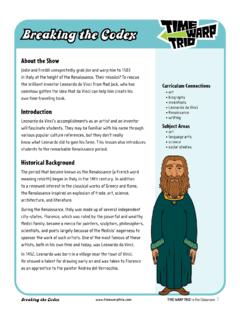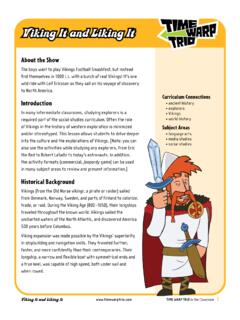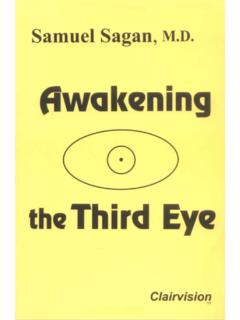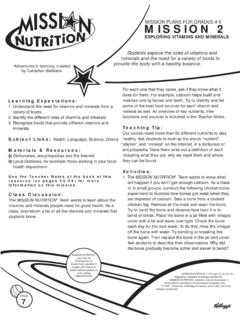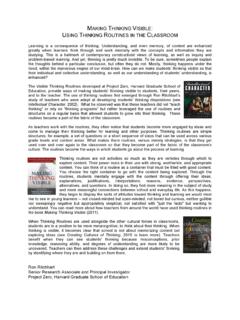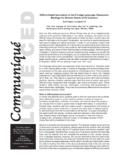Transcription of See You Later, Gladiator! - The Time Warp Trio
1 see you later , gladiator ! About the Show The Book transports Joe, Sam and Fred back to ancient Rome 120 and face-to-face with one big ol' gladiator . They've seen plenty of professional wrestling on TV but will the smackdown body slam be enough to save them at the Coliseum? Curriculum Connections Introduction ancient civilizations ancient Rome Studying gladiators in ancient Rome a perennial favorite topic gladiators for students can lead to discussions about stereotypes and myths. Subject Areas In exploring the images of gladiators in popular culture versus art language arts historical reality, students can explore the research process as social studies well as the complexities involved in discerning fact from fiction.
2 Historical Background Roman gladiators were trained in mortal combat, a form of public entertainment in ancient Rome. The word gladiator comes from the Latin word gladius (sword). Wealthy or important Romans often asked for funeral games to be held in their honor. In 264 six men were hired to fight at a funeral probably the first gladiators. The popularity of the games grew and spread throughout the Roman empire. Eventually gladiatorial games became lavish public entertainments, especially after the Coliseum in Rome opened in 80 Roman gladiators were usually convicted criminals, slaves, or prisoners of war. Many gladiators came from the lands Rome had conquered. Although there were a few women gladiators, in 200 women were banned from fighting.
3 see you later , gladiator ! Time Warp Trio In the Classroom . see you later , gladiator ! Historical Background continued Some gladiators who managed to survive the fierce fighting became famous or even wealthy. Men of the very lowest social rank sometimes bound themselves to the owner of a gladiator troupe, enduring branding, chains, flogging, and brutality at the hands of their masters to become gladiators. Gladiators went through intense training and were taught complex moves so they could better entertain the audience. Gladiators were supposed to fight to the death, but if they fought extremely well the crowd could decide to spare both fighters. The crowd voted by showing thumbs up or thumbs down although whether or not thumbs up meant life has not been verified.
4 Sometimes gladiators won prize money. At a large event there could be hundreds of gladiators. In the Coliseum, the audience could be as large as 50,000 people. After other entertainments in the morning, such as hunting wild animals and the execution of criminals, gladiators would enter the arena. They would approach the emperor and proclaim, Ave, Imperator, morituri te salutamus (Hail, Emperor, we who are about to die, salute you). As Christianity spread and the power of the Roman Empire declined, the appeal of the games diminished. In 326 Constantine began the process of abolishing gladiator games. In 400 Emperor Honorius banned gladiators forever. re Want students to get even mo excited about hi story?
5 Check out the gladiators adventure for kids at Sandwiches of Time and other interactive games to play. P lentifax 487 the ultimate time traveler's guide to find out how gladiators lived and fought! Cool Books that kids will love. see you later , gladiator ! Time Warp Trio In the Classroom . Activity 1. Let The Games Begin! Students compare what they think they know about gladiators with facts they learn through research. They then use the information to act as reporters and write an article about a gladiatorial game. Instructions Objectives t o expand students' knowledge 1. B oth the book and the show see you later , gladiator portray Horridus of ancient Rome and gladiators.
6 As a laughable figure, but being a gladiator was not so funny. Ask students to practice research skills to volunteer what they already know about gladiators. Create a two- column chart entitled Gladiators. Label one column Fact and the other Materials column Fiction. art and writing supplies chart paper and easel 2. Divide the class into small groups. Explain that students will be researching gladiators, the conditions under which they lived and fought, and how they Curriculum Standards have been portrayed in books, movies, and legends. NCSS. 3. After students share what they have learned, revisit the chart. Which Individuals, Groups, and Institutions: Students items are facts?
7 Fiction? Add new information to the chart and discuss the demonstrate an understanding differences between the fictional portrayals and real gladiators. of concepts such as role, status, 4. A sk students to act as reporters and write an article describing and social class in describing the a gladiatorial game they have just seen. Encourage students to include interactions of individuals and as many details as possible about the crowd, the events of the day, social groups. the emperor, the outcome of the games, what the gladiators wore, what NCTE/IRA. nationality they were, etc. Students use spoken, written, and visual language to 5. Y ou may want to offer students the option of being sportscasters.
8 Accomplish their own purposes Working in pairs, students can interview a gladiator after a game. They ( , for learning, enjoyment, will need to convey the information they have learned as they ask persuasion, and the exchange and answer questions. (Students may want to write a script of the of information.). interview beforehand.). Take It Further Have the students work together to create a mural of an ancient Roman town with a stadium on game day. see you later , gladiator ! Time Warp Trio In the Classroom . Activity 2. gladiator Step Book This activity helps students use similes in their writing and then present their knowledge about gladiators in the form of a step book.
9 Instructions 1. A sk students to use their imagination to visualize how a gladiator looks, Objectives t o improve students'. sounds, smells, etc. understanding and use 2. A sk the students the following questions. Encourage a wide variety of of language answers. Record their responses on the board. t o create similes t o expand students' knowledge What do gladiators look like? of ancient Rome What do gladiators sound like? How do gladiators smell? Materials How do gladiators eat? art and writing supplies What might a gladiator feel like? 3 sheets of white 8 1/2 x 11 . paper per student 3. Distribute three sheets of paper to each student. Show students how to arrange the paper so they have a one-inch overlap on each page.
10 Each flap Curriculum Standards is a step. Demonstrate how to fold the paper into a six-page Step Book NCSS. Individual Development and Identity: Students relate such Illustration: How to Make a Step Book factors as physical endowment 2002 by Tarry Lindquist from Seeing and capabilities, learning, the Whole Through Social Studies, motivation, personality, Second Edition. Portsmouth, NH: perception and behavior to Heinemann. individual development. NCTE/IRA. Students apply knowledge of language structure, language conventions, ( , spelling and punctuation, media techniques, figurative language, and genre). to create, critique, and discuss print and non-print texts. see you later , gladiator !
